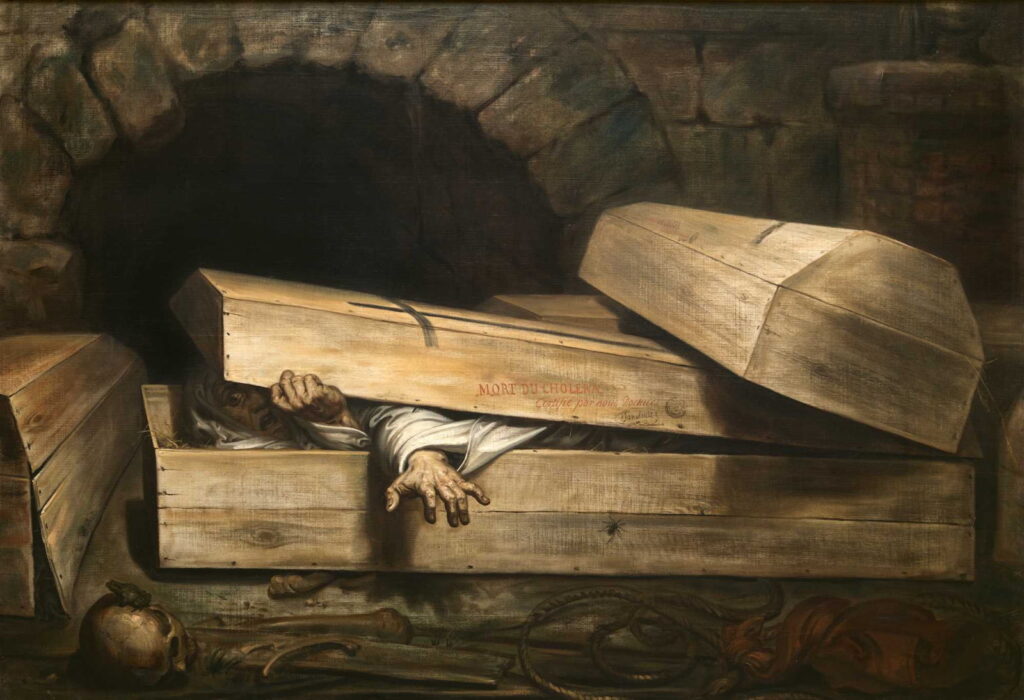Urban Revolutionaries: 14 Epidemic

Since the dawn of civilisation in the cities of the Fertile Crescent in what’s now the Middle East, epidemics of infectious diseases have been a curse of those concentrations of people, as well as in armies. In classical times, both Athens and Rome were struck by epidemics of what’s likely to have been bubonic plague.
Michiel Sweerts (1618–1664), Plague in an Ancient City (c 1652-1654), oil on canvas, 118.7 x 170.8 cm, Los Angeles County Museum of Art, Los Angeles, CA. Wikimedia Commons.
Michiel Sweerts’ painting of Plague in an Ancient City from about 1652-54 is believed to show Athens during one of these epidemics. The moribund and the dead litter the streets, and normal life has collapsed.
The pandemic known as the Black Death that started in about 1338 was different, though. Changing climate in the grasslands of Asia led to the movement of rodent populations into cities, and those rodents brought with them fleas carrying highly infectious diseases for humans, notably Yersinia pestis, the cause of bubonic plague.
Luigi Sabatelli (1772-1850), The Plague of Florence in 1348 (date not known), engraving after original work by Sabatelli, illustration to an edition of Boccaccio’s Decameron, The Wellcome Collection, London. Courtesy of The Wellcome Foundation, London, via Wikimedia Commons.
Doubt has been cast that Boccaccio’s description of the Black Death in Florence was based on his personal experience, but few alive at the time could have escaped witnessing its deadly consequences. Much later, in the early nineteenth century, Luigi Sabatelli made this undated engraving to illustrate an edition of the Decameron, in The Plague of Florence in 1348.
Jacopo Tintoretto (c 1518-1594), Saint Roch Heals Plague Victims (1559), oil on canvas, 307 x 673 cm, Chiesa di San Rocco, Venice, Italy. Image by Didier Descouens, via Wikimedia Commons.
Venice was particularly prone to outbreaks of plague, and developed procedures and establishments for coping with cases. In Tintoretto’s painting of Saint Roch Heals Plague Victims from 1559, those suffering from plague have been brought to this small chapel, where the saint is healing them. The dark room is already collecting a disarray of bodies, some seemingly close to death. Without the miraculous work of the saint, this would quickly have become the waiting room for hell. There were twenty-two outbreaks of plague recorded in Venice between 1361-1528, and a single epidemic in 1576-77 killed almost a third of its population.
Francisco de Goya (1746–1828), Plague Hospital (from The Disasters of War) (1808-10), oil on canvas, 32 x 57 cm, Museo Nacional del Prado, Madrid, Spain. Wikimedia Commons.
Goya’s painting of a Plague Hospital from his disturbing series The Disasters of War (1808-10) shows management of an outbreak that occurred during the Peninsular War of 1808-14.
Arnold Böcklin (1827–1901), The Plague (1898), tempera on fir, 149.5 x 104.5 cm, Kunstmuseum Basel, Basel, Switzerland. Wikimedia Commons.
Arnold Böcklin reminds us that the spectre of death is never far away in The Plague, painted in 1898. This coincided with the late stage of a pandemic that had started in China in 1855, and in the last years of the century was circulating through different ports around the world, in Hong Kong in 1894, and Mumbai in 1896. That reached San Francisco in 1900-04.
As plague became less of a problem in the cities of Europe and North America in the nineteenth century, so other diseases took hold, including cholera, influenza and tuberculosis. Six pandemics of cholera swept cities across the world in the century from 1817. Spread largely in drinking water contaminated by human faeces, improvements in sanitation introduced by redevelopment of cities like London and Paris were decisive in bringing it under control.
Carlos Schwabe (1866–1926), Dusk (1895-1900), illustration for ‘Les Fleurs du Mal’ (Flowers of Evil) by Charles Baudelaire, Paris, 1900, location not known. Wikimedia Commons.
Carlos Schwabe’s painting titled Crepuscule in the French original is more likely to refer to Dawn rather than dusk. This giant female figure of “dawn, shivering in her green and rose garment, was moving slowly along the deserted Seine”. This was an illustration for a 1900 edition of Les Fleurs du Mal (Flowers of Evil) by Charles Baudelaire.
Edvard Munch (1863–1944), The Hearse on Potsdamer Platz (1902), 68 x 97.5 cm, Munchmuseet, Oslo. PubHist.
Edvard Munch completed two versions of Hearse on the Potsdamer Platz in 1902. These depict a horse-drawn hearse in this famous square in the heart of Berlin. Amid its bright hues is the hearse, covered in a black pall, and drawn by a single black horse. Munch’s father was a doctor, and both his mother and older sister died of tuberculosis during the artist’s childhood in Oslo.
Finally, here’s a glimpse of one of the obsessions of the nineteenth century: the fear of being buried while still alive.
Antoine Wiertz (1806–1865), Premature Burial (1854), oil on canvas, 160 × 235 cm, Le Musée Antoine Wiertz, Brussels. Wikimedia Commons.
After his mother’s death, the eccentric artist Antoine Wiertz became increasingly obsessed with death. Premature Burial (1854) visits a not uncommon dread in the nineteenth century: that of being presumed dead, buried, then recovering to find yourself in a coffin.
This did happen, particularly during cholera epidemics, as indicated by the lettering on the opening coffin. The profound shock resulting from choleric dehydration could make the pulse and breathing so feeble as to escape detection; with hundreds or thousands of dead, many were dumped hurriedly into mass-produced coffins and so into mass graves. And a very few managed to survive.
Coffins were designed with bells which could be rung by a recovered person. Wiertz’s victim is left with the nightmare scenario of trying to make it back to the land of the living.




